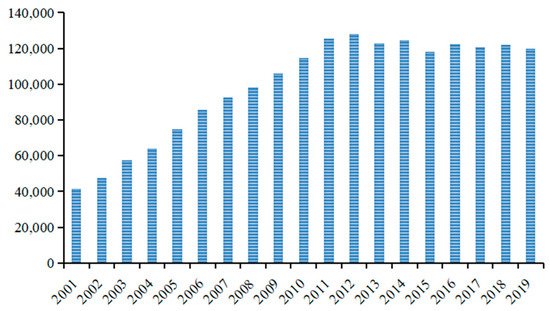Your browser does not fully support modern features. Please upgrade for a smoother experience.
Please note this is an old version of this entry, which may differ significantly from the current revision.
Subjects:
Green & Sustainable Science & Technology
碳排放效率是环境科学中的一个重要概念;是指同时产生碳排放的生产活动所产生的经济效益。单位经济产出产生的碳排放越少,碳排放效率越高。
- carbon emission efficiency
- spatial connection
- social network analysis
- influencing factors
一、简介
Climate change and its impacts have become one of the most serious environmental problems facing the world today [1]. In its fourth Global Climate Assessment, the United Nations Intergovernmental Panel on Climate Change (IPCC) noted that it is an indisputable fact that human activities and massive greenhouse gas emissions are the major causes of global climate change. As CO2 is one of the most important greenhouse gases, it is closely related to global warming [2]. As the main source of carbon emissions, cities have a profound impact on the realization of carbon emission reduction targets [3]. Establishing low-carbon cities is an inevitable choice for China in order to deal with climate change and to develop a low-carbon economy [4].
Based on the above, carbon emission and carbon emission reduction issues have been given extensive attention, and studies on carbon emission estimation methods [5], influencing factors [6,7,8], emission intensity [9,10], and emission efficiency [11] have been carried out successively. Carbon emission efficiency is an important concept in environmental science; it refers to the economic benefits generated by production activities that produce carbon emissions at the same time [12]. The less carbon emissions generated per unit of economic output, the more carbon emission efficient it is. Carbon emission efficiency considers the promotion and inhibitory effect of carbon emissions on economic growth, and measures the level of economic growth under carbon emission restrictions—this has been widely studied. In the context of tightening carbon dioxide emission constraints, the currently used crude economic development approach is unsustainable, and improving carbon efficiency is an important way to promote a change to the development approach. At present, most studies focus on regional differences in carbon emission efficiency, and less attention has been paid to region-specific carbon emission efficiency correlations.
作为世界主要城市群和大都市圈的典型代表,长三角地区从早期工业化和城市化进程中就处于高度发达的状态,拥有大量的石油化工、冶金、造纸、和汽车。工业高强度发展带来的能源和碳排放给长三角城市群带来了巨大的环境压力(图1),影响了区域的可持续发展和减排承诺的履行。

图1. 2001-2019年长三角城市群碳排放(来源:摘自DMSP/OLS夜灯数据)。
同时,网络化交通体系的逐步形成,信息技术的不断发展,区域经济一体化的不断推进,使长三角各城市的生产要素之间的空间联系日益紧密,区域间的碳排放效率也表现出显着的空间相关性特征。从网络视角考察长三角城市群城市能源碳排放效率的空间关联结构及影响因素,探讨城市群碳排放效率的地位和作用,具有重要的理论意义和应用价值。空间相关网络中的每个区域,为构建经济新常态下跨区域碳排放效率协同机制,制定针对性、系统性的碳减排政策。也可以填补当前学术领域在区域碳排放效率空间相关性研究方面的空白。
2. 碳排放效率文献综述
目前,碳排放效率的定义可分为单要素碳排放效率和全要素碳排放效率两种。Kaya 和 Yokobori 首次将碳排放效率定义为单因素视角下的碳生产率;即同期GDP与碳排放之比[ 13 ]。Yamaji 在研究日本的碳排放水平时将 CO 2 排放总量与 GDP 的比率定义为 CO 2 生产率 [ 14 ]。Mielnik、Goldember 和 Ang 将单位能源消耗的二氧化碳排放量作为衡量碳排放效率的重要指标[ 15、16]。单因素只考虑GDP或能源消耗与碳排放的比例,而忽略了多因素组合投入实际生产过程中的因素之间的替代作用。Ramanatha 认为,碳排放效率的定义应融入能源消费、经济发展和碳排放三个框架中,使评价结果全面合理[ 17 ]。Zaim 和 Taskin 将碳排放定义为非预期产出变量,并提出了综合效率指数的概念,并将该指数应用于 OECD 国家研究[ 18 ]。
The current research on carbon emission efficiency can be divided into industries and regions according to the research objects. In the research of industry carbon emission efficiency, scholars have used different measurement models to measure the carbon emission efficiency of different industries in the national economy. Wang Kai and Wang Kun used the SBM model, and found that the carbon emission efficiency of China’s tourism showed a significant spatial imbalance [19]; Dwyer et al. measured carbon emissions from tourism in Australia using both the production and expenditure approaches [20]; Hampf proposed a new DEA analysis method based on an efficiency analysis perspective to investigate the standard of CO2 emissions in the U.S. electric power industry [21]; and Erwin et al. used a sample of Indonesian manufacturing firms to explore the determinants of carbon emissions [22]. In terms of regional carbon emission efficiency research, Ramanathan used the data envelope analysis (DEA) to build an input−output index system containing carbon dioxide emissions, energy consumption, and economic activity variables, to compare the carbon emission performance level of various countries [17]. Zhang et al. developed a spatial regression model to study the convergence characteristics and influencing factors of carbon emission intensity in Chinese cities and major strategic regions [23]. Meng et al. used the RAM-DEA model to estimate the low-carbon economic efficiency of the Chinese industrial sector from 2001 to 2013, and found that most industries of low-carbon economic efficiency are still at a low level; however, the carbon emission efficiency was greatly improved during the study period [24].
In addition, many academic studies have confirmed that carbon-emission-related problems do not exist independently among regions, but they have some spatial correlations between them [25,26]. Grunewald and others explored the driving factors of spatial differences in carbon emissions and pointed out that energy intensity and energy structure are the main reasons for the spatial differences in carbon emissions [27]. Marbuah and Mensah performed a statistical test of the spatial association of several pollutants, including CO2, using 290 Swedish urban areas as the study areas, showing that spatial spillover effects were the main driver of the environmental Kuznets curve [28]. Wu studied the spatial pattern and evolution mechanism of carbon emission reduction in China through spatial econometrics, and analyzed the emission reduction characteristics of key provinces [29]. Zhou determined the determinants and spatial relationship of CO2 emissions at an urban level in China [30].
Previous studies have also discussed and analyzed the influence mechanism of regional carbon emission efficiency in depth. Wang et al. used the window SBM analysis method to measure the carbon emission efficiency and emission reduction potential of various provinces and cities in China from 2003 to 2016, and analyzed the impact of resource endowment on emission efficiency using the panel Tobit model. The results show an inverse relationship between resource endowment and emission efficiency [31]. Liu et al. proposed the ideal point cross efficiency (IPCE) model, and used this model to analyze the carbon emission efficiency of the top ten urban agglomerations in China in 2008–2015. The results showed that the population effect and economic effect promoted the emission efficiency of mature urban agglomerations, while reducing the efficiency of emerging urban agglomerations [32]. Zhou et al. measured the carbon efficiency of the top 18 global carbon emitting countries from 1997 to 2004 based on a DEA model, and found that technological progress had a significant effect on the improvement of carbon efficiency [33]。Ma Y. 和 Lu Y. 使用超效率 SBM 模型计算了 1995 年至 2012 年中国省级碳排放效率,并检验了自主创新、FDI 和国际贸易的影响。结果发现,FDI可以显着提高碳排放效率,而自主创新和进口则具有抑制作用[ 34 ]。
This entry is adapted from the peer-reviewed paper 10.3390/su14106114
This entry is offline, you can click here to edit this entry!
